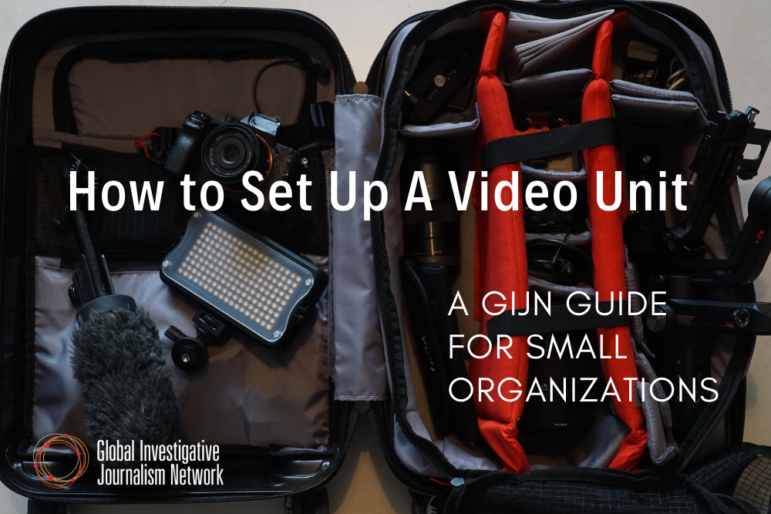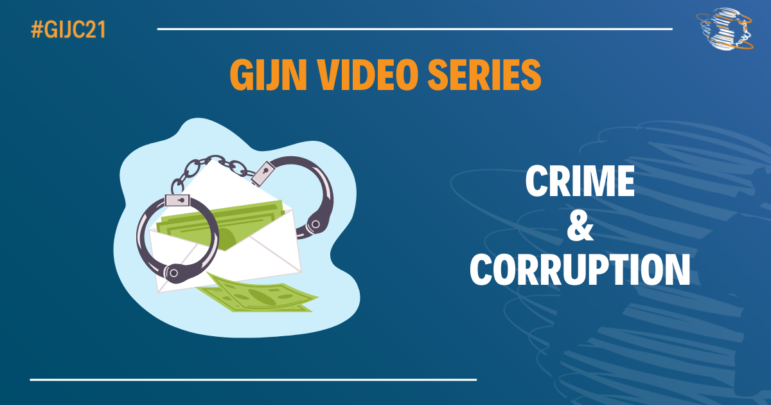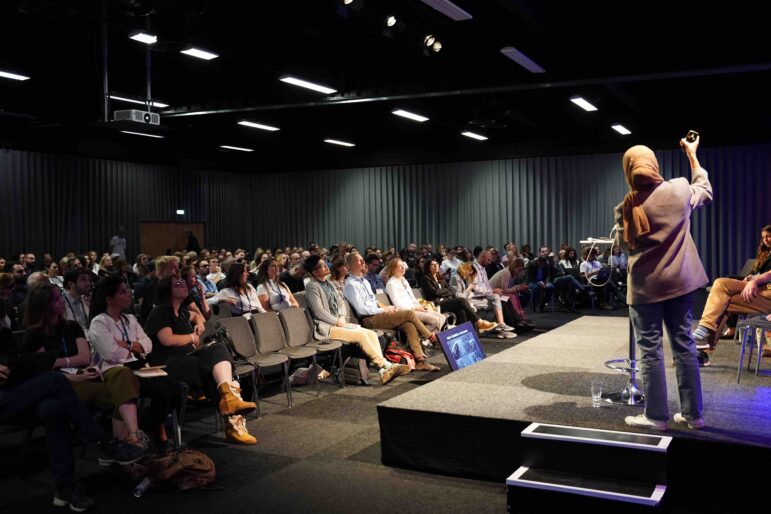

The leadership of the Romanian news site Recorder discusses their success with video investigations and a nonprofit, donor-driven revenue model at a panel at IJF24 in Perugia, Italy. Image: Courtesy of IJF24, Ilaria Sofia Arcangeli
Romania’s Recorder: Finding a Unique Revenue Model for Independent Media
Read this article in
The founders of Recorder, an independent Romanian investigative NGO specializing in video and documentaries, discovered the right business model by accident.
Launched in 2017 with plans for an advertising revenue model, 90% of its income now comes from its audience. “Like Christopher Colombus, they sailed out trying to find the Indies and ended up in the Americas,” panel host and Romanian journalist Cristian Lupsa told attendees of the 2024 International Journalism Festival (IJF) in Perugia as he introduced Recorder’s leadership team.
Journalists Cristian Delcea and Mihai Voinea left established careers at the Romanian newspaper Adevărul to found Recorder alongside two other part-time founders. The newsroom started with four people and focused on event-driven, video stories. Its first report, on a religious event organized by then-Bucharest mayor Gabriela Firea, was a 15-minute video — published before its website was ready. The team went directly to Facebook and the video became an instant hit, with more than 500,000 views in 24 hours — sending 20,000 followers to its page.
“More importantly, we had many comments telling us that they want to donate and support us,” Mihai Voinea said. The team set up a PayPal account to receive donations, he explained: “The video created a business.”
Video is still Recorder’s primary focus, and it now produces longer, documentary-style films alongside shorter reports. Its team has expanded to 20 full-time staff and four regular contributors.
Organizational and institutional corruption and lack of transparency from, and abuse of democracy by, those in power are central topics for the Recorder team. Recent stories include an investigation into Romania’s ‘garbage mafia,’ an exposé on why Romanians are resigning from the army, and an interrogation of President Klaus Iohannis’ travel expenditure.

Recorder Executive Manager Alina Paduraru, speaking at IJF24, noted that two-thirds of her site’s audience is younger than 30 years old. Image: Courtesy of IJF24, Ilaria Sofia Arcangeli
At launch, Recorder’s mission was to create a kind of media that didn’t already exist in Romania — an independent newsroom, not influenced by politicians or businessmen, Alina Paduraru, executive manager of Recorder, told GIJN. “We felt that the Romanian media landscape needed this kind of video product and it happened that the younger generation was more attracted to this content,” she says.
These are complicated subjects and Recorder’s founders are keenly aware that they need to make them appeal to a young and potentially distrusting or news-avoidant audience — just one in three members of the public online in Romania trusts the country’s media. According to Paduraru, 64% of Recorder’s audience is now under 30 years old.
“We managed to make a younger generation interested in journalism, which didn’t happen before,” she told GIJN, adding that the younger age of the Recorder team helps them to produce stories in formats that appeal to these audiences.
“I try to think about the 18-year-old voting for the first time this year in Romania, about his needs, what he needs to know, because a lot of young people may not know about politics or how the state operates,” Cristian Delcea, co-founder and co-editor-in-chief of Recorder, told the IJF audience. “We need to be close to this kind of audience and to package in a way that they can follow an investigation until the end and understand something.”
Focus on Format
The team has spent much time thinking about how stories are packaged so audiences can follow complicated investigations and stay interested to the very end. Delcea shared four lessons on how Recorder approaches this:
- Think about the first thing the public will see in your video story. Delcea gave the use of graphic, cartoon-design thumbnails in Recorder’s investigative film on the misuse of public funds by the Romanian Orthodox Church as an example. “We try to make it beautiful and to create something that tells the story,” he explained. “This image is now iconic in Romania.”
- Recorder’s investigations have introductions and trailers that wouldn’t look out of place on Netflix or HBO. “We want something more dramatic that brings new information and captures attention so people understand it’s important to watch this,” he said.
- Creating strong infographics for video helps with complicated investigations. The Recorder team can see from YouTube data that these are often the most-watched parts of their videos: “People rewind and try to watch things again.”
- Recorder uses music and admits this can be a difficult element to manage. “It can ruin the material, but when used properly the effect is important, especially when you need emotion,” said Delcea. During its film on the COVID-19 pandemic, hospital nurses told Recorder they were haunted by the beeping sounds of intensive care machines. The newsroom commissioned an original composition for the documentary that reflected this sound as a different way to engage the audience in the story.
Recorder says its videos average more than 900,000 views, making them at times more popular than entertainment shows on YouTube during the past year. “This is very important because that’s what journalism should do, we should reach a lot of people so that decision-makers cannot ignore the topic, and feel the social pressure,” said Delcea.

Recorder’s investigation into the Romanian Orthodox Church is a video-first piece that uses highly produced graphics to tell the story. Image: Screenshot, YouTube, Recorder
Growing a Reader Revenue Model
In the beginning, the Recorder founders saw advertising or investment from an “honest” funder as their likely routes to revenue. In its first year, the newsroom revenue was a 70%/30% split between advertising and donations, but the team saw a wave of donations each time a new investigation was published.
“The founders didn’t have a model to follow; we created this model for other media outlets in Romania,” Paduraru told GIJN.
Fast-forward seven years, and more than 90% of Recorder’s €1.2 million (US$1.3 million) annual revenue in the previous financial year came from the audience, with the remainder from grants or advertising.
“We had to make a choice and decide whether we are a for-profit model or a nonprofit model. We are journalists, not businessmen, so we chose nonprofit,” Mihai Voinea said at the IJF24 event.
Recorder takes donations by phone and through online payments via its website, PayPal, YouTube channel membership, and Patreon. Donations will peak in the wake of a big investigation. The team has previously used audiences’ willingness to pay for entertainment streaming services, such as Netflix, in messages to call for donations to support its journalism, which run in articles on its website, in its weekly newsletter, in social posts, and in the description of its YouTube videos.

Recorder Co-Editor-in-Chief Cristian Delta discussed his site’s video investigations at IJF24. Image: Courtesy of IJF24, Ilaria Sofia Arcangeli
The newsroom’s biggest source of reader revenue — which they say was more than €457,000 (US$494,000) in the last financial year — is through a tax facility in Romania that allows audience members to direct 3.5% of their income tax to a selected NGO.
Recorder is transparent about how much money it receives and from what sources, as well as how it spends that revenue. The team said supporters are happy when they learn of new equipment bought, reporters hired, or investigations funded. Almost 10,000 people support the newsroom with a recurring donation — one indication that Recorder is building a loyal audience — and the average donation is €7 (US$8). Supporters also buy merchandise and attend Recorder film screenings and public talks.
“It gives us hope that the younger generation is growing up admiring investigative journalism,” said Paduraru. Building greater trust in media can also lead to greater support from the public for media, she added.
Audience Feedback
The newsroom launched an audience survey in 2023 aiming to generate 5,000 responses; it received more than 30,000. The answers helped Recorder understand why its audience supports the newsroom.
“We help them keep up with the news and feel more represented in Romanian society,” Paduraru explained.
The survey results also told the team that 30% of respondents felt the need to leave the country after watching Recorder’s investigations, but 50% were motivated to become more civically engaged following its reporting.
The team has already leaned into this feedback, asking readers to get involved in an investigation into the costs of luxury private planes used by the Romanian president. The newsroom asked its audience to send emails to the administration asking it to reveal the costs — 41,000 people sent an email but the president has yet to respond. “We’re wondering how many citizens a president can ignore,” said Paduraru.
Alongside sending donations, Recorder’s audience sends daily news tips and evidence of corruption and harassment that contribute to the newsroom’s investigations. “All these things prove that our audience trusts us and we couldn’t be more grateful,” she added.
Watch the full IJF24 panel with Recorder on YouTube below.
 Laura Oliver is a freelance journalist based in the UK. She has written for the Guardian, BBC, Euronews, and others. She is a regular journalism trainer for the Thomson Foundation and Thomson Reuters Foundation and works as an audience strategy consultant for newsrooms. You can find her work here.
Laura Oliver is a freelance journalist based in the UK. She has written for the Guardian, BBC, Euronews, and others. She is a regular journalism trainer for the Thomson Foundation and Thomson Reuters Foundation and works as an audience strategy consultant for newsrooms. You can find her work here.









